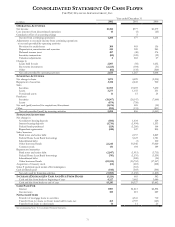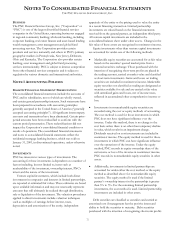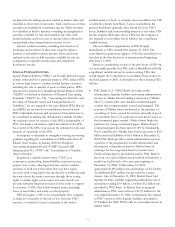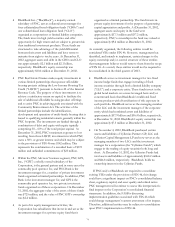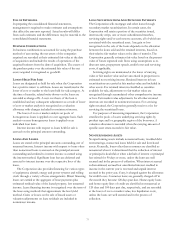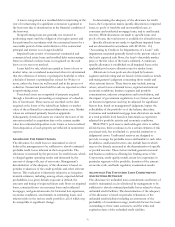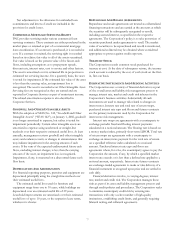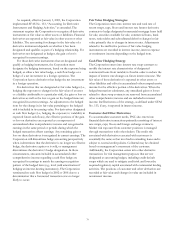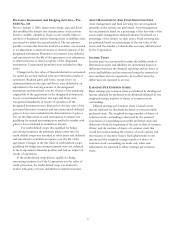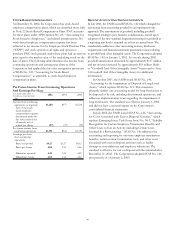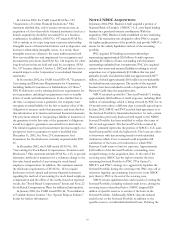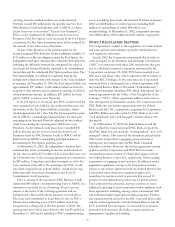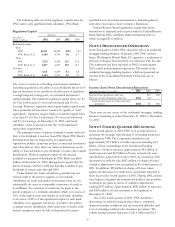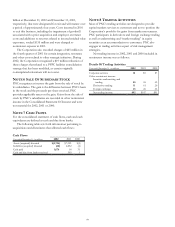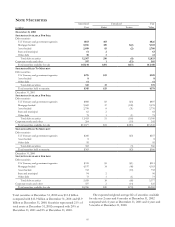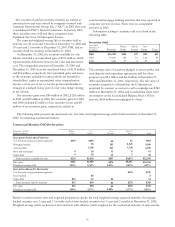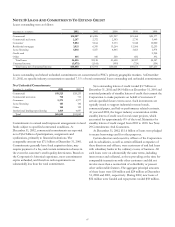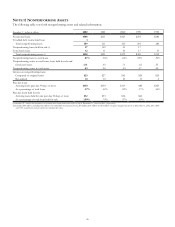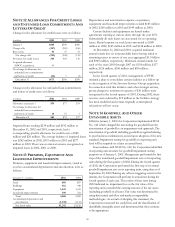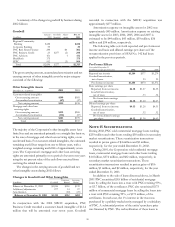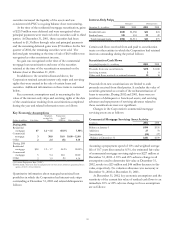PNC Bank 2002 Annual Report Download - page 83
Download and view the complete annual report
Please find page 83 of the 2002 PNC Bank annual report below. You can navigate through the pages in the report by either clicking on the pages listed below, or by using the keyword search tool below to find specific information within the annual report.81
In October 2002, the FASB issued SFAS No. 147,
"Acquisitions of Certain Financial Institutions." This
statement clarified that, only if certain criteria are met, an
acquisition of a less-than-whole financial institution (such as a
branch acquisition) should be accounted for as a business
combination. In addition, SFAS No. 147 amends SFAS No.
144 to include in its scope long-term customer-relationship
intangible assets of financial institutions such as depositor- and
borrower-relationship intangible assets. As a result, those
intangible assets are subject to the same undiscounted cash
flow recoverability test and impairment loss recognition and
measurement provisions that SFAS No. 144 requires for other
long-lived assets that are held and used by a company. SFAS
No. 147 became effective October 1, 2002 and did not have a
material impact on the Corporation’s consolidated financial
statements.
In November 2002, the FASB issued FIN 45, "Guarantor’s
Accounting and Disclosure Requirements for Guarantees,
Including Indirect Guarantees of Indebtedness of Others."
FIN 45 elaborates on the existing disclosure requirements for
most guarantees, including loan guarantees such as standby
letters of credit and indemnifications. It also clarifies that at
the time a company issues a guarantee, the company must
recognize an initial liability for the fair or market value of the
obligations it assumes under that guarantee and must disclose
that information in its interim and annual financial statements.
The provisions related to recognizing a liability at inception of
the guarantee for the fair value of the guarantor’s obligations
would not apply to guarantees accounted for as derivatives.
The initial recognition and measurement provisions apply on a
prospective basis to guarantees issued or modified after
December 31, 2002. See Note 29 Commitments And
Guarantees for the disclosures currently required under FIN
45.
In December 2002, the FASB issued SFAS No. 148,
"Accounting for Stock-Based Compensation--Transition and
Disclosure." This statement amends SFAS No. 123, to provide
alternative methods of transition for a voluntary change to the
fair value based method of accounting for stock-based
employee compensation. In addition, this statement amends
the disclosure requirements of SFAS No. 123 to require
disclosures in both annual and interim financial statements
regarding the method of accounting for stock-based employee
compensation and the effect of the method used on reported
results. See "Stock-Based Compensation" herein and Note 22
Stock-Based Compensation Plans for additional information.
In January 2003, the FASB issued FIN 46, "Consolidation
of Variable Interest Entities." See “Special Purpose Entities”
herein for further information.
NOTE 2 NBOC ACQUISITION
In January 2002, PNC Business Credit acquired a portion of
National Bank of Canada’s (“NBOC”) U.S. asset-based lending
business in a purchase business combination. With this
acquisition, PNC Business Credit established six new marketing
offices. The transaction was designed to allow PNC to acquire
the higher-quality portion of the portfolio, and provide NBOC a
means for the orderly liquidation and exit of the remaining
portfolio.
PNC acquired 245 lending customer relationships
representing approximately $2.6 billion of credit exposure
including $1.5 billion of loans outstanding with the balance
representing unfunded loan commitments. PNC also acquired
certain other assets and assumed liabilities resulting in a total
acquisition cost of approximately $1.8 billion that was paid
primarily in cash. Goodwill recorded was approximately $277
million, of which approximately $101 million is non-deductible
for federal income tax purposes. The results of the acquired
business have been included in results of operations for PNC
Business Credit since the acquisition date.
NBOC retained a portfolio (“Serviced Portfolio”) totaling
approximately $662 million of credit exposure, including $463
million of outstandings, which is being serviced by PNC for an
18-month term unless a different date is mutually agreed upon.
In June 2002, NBOC and PNC reached final agreement as to
the Serviced Portfolio’s financial information. As such, certain
financial data previously disclosed with regard to the NBOC
Serviced Portfolio has been modified to reflect the terms of
this revised agreement. The Serviced Portfolio retained by
NBOC primarily represents the portion of NBOC’s U.S. asset-
based loan portfolio with the highest risk. The loans are either
to borrowers with deteriorating trends or with identified
weaknesses which if not corrected could jeopardize full
satisfaction of the loans or in industries to which PNC
Business Credit wants to limit its exposure. Approximately
$138 million of the Serviced Portfolio outstandings were
nonperforming on the acquisition date. At the end of the
servicing term, NBOC has the right to transfer the then
remaining Serviced Portfolio to PNC (“Put Option”).
NBOC’s and PNC’s strategy is to aggressively liquidate the
Serviced Portfolio during the servicing term. PNC may sell or
otherwise liquidate any remaining loans in the event NBOC
puts them to PNC at the end of the servicing term.
NBOC retains significant risks and rewards of owning the
Serviced Portfolio, including realized credit losses, during the
servicing term as described below. NBOC assigned $24
million of specific reserves to certain of the loans in the
Serviced Portfolio. Additionally, NBOC absorbs realized
credit losses on the Serviced Portfolio in addition to the
specific reserves on individual identified loans. If during the


